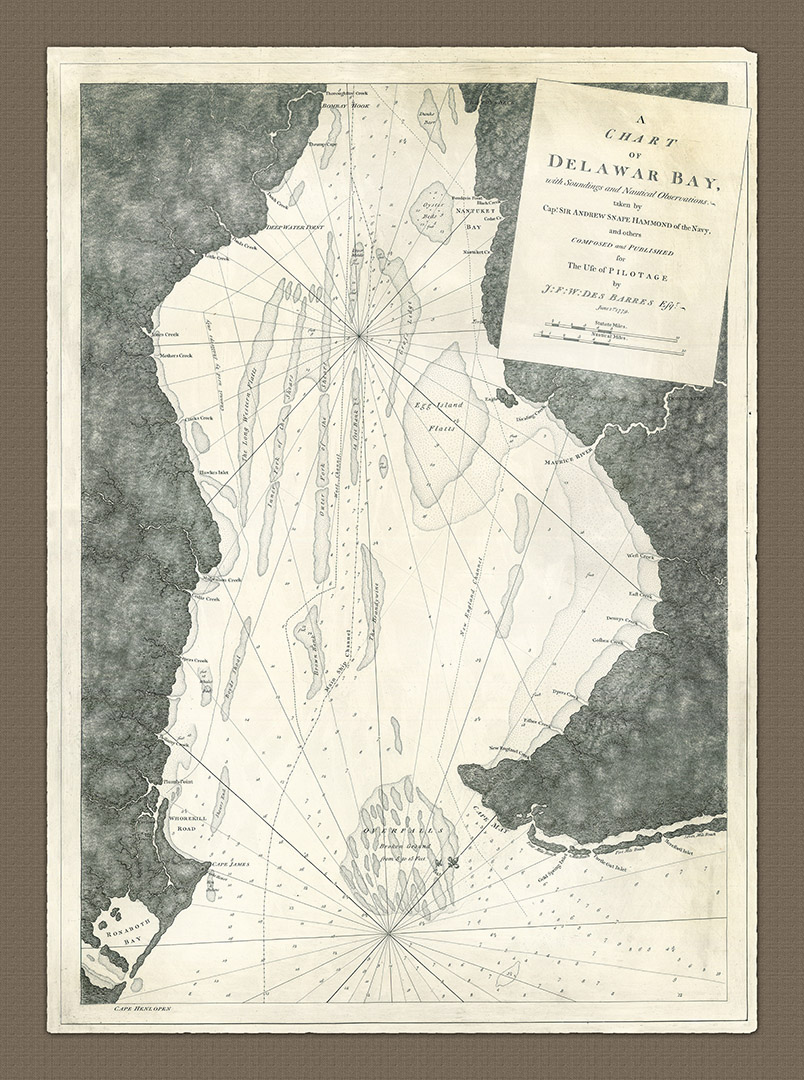
A302 - A chart of Delaware Bay with soundings and nautical observations
A detailed chart containing 'soundings and nautical observations taken by Captain Sir Andrew Snape Hammond of the Navy, and others'. It was composed and published for the use of pilotage by J.F.W. Des Barres Esq. June 1st 1779 for inclusion in the Atlantic Neptune folio.
The image is very strong with the land strongly hachured and the river features including clearly marked. The three main shipping channels are shown up as far as Bombay Hook, as are other details such as oyster beds, sand flats, marshes and 'barrs'.
- 1779
- J.F.W. Des Barres & Andrew Snape-Hammond
- h34.5" x w26"
- P
The image is very strong with the land strongly hachured and the river features including clearly marked. The three main shipping channels are shown up as far as Bombay Hook, as are other details such as oyster beds, sand flats, marshes and 'barrs'.
The edition presented here is taken from a 'pull' (print) made by the British Admiralty in about 1947 from Des Barres' original copper plates, before the plates were presented to the US government. The result of the pull was that we are presented with an authentic view of what the charts of the Atlantic Neptune would have looked like when they were originally made. The chart was originally published in two parts.
From the outset of the Revolutionary War, the British had recognized the importance of the major rivers, estuaries, harbors and ports of the southern middle states of the colonies, and had in many cases already started surveying them for navigation. These rivers posed a genuine, economic, and military threat to the British. The Delaware River split New Jersey and Maryland, and was the arterial link to Philadelphia; the Chesapeake River and all of the rivers therein provided links to all of the major towns and cities of Virginia; and the rivers and inlets of the Carolinas provided links to the slave and spice trade.
Snape-Hammond arrived in the area on HMS Roebuck in February 1776 to assist the Governor of Virginia, Lord Dunmore, in his campaign to re-gain control of the colony and quell the rebels throughout the Chesapeake Bay. Between March and May, he moved north to orchestrate a blockade on the Delaware Bay region, and it was at this time that he likely started the survey for this chart. He found the channel to be a veritable maze of difficult passages and channels with strong currents and tides. As part of this reconnaissance (and a need to replenish fresh water stocks) Snape-Hammond decided to move as far up-river a possible toward Philadelphia. It was a daring move and it provided Hammond with more vital information: The Pennsylvanian rebels had built a small naval force consisting of over a dozen ships, and they had fortified the islands and narrows with forts and batteries. They had even constructed a chivaux-de-frise (sharpened stakes with metal tips) in order to force advancing ships into channels under the guns of the batteries.
In March 1777, Captain Hammond was invited by the Admiral Richard Howe to a meeting with the Admiral's brother, General William Howe, to discuss and plan an attack on Philadelphia. That the Howe brothers eventually decided, quite remarkably, to attack Philadelphia via the Chesapeake rather than via the Delaware river is undoubtedly down to the information Hammond gave them based on his expert experience.
The chart was made by Des Barres after the British had taken Philadelphia on 26th September 1777. On an earlier chart of the upper Delaware River produced by J.F.W. Des Barres and Lt. John Hunter (see Heritage Charts A305) it is possible to see many of the features and obstacles described above (including the position of HMS Roebuck) as on the 15th November 1777 as part of General Howe's campaign against Philadelphia to capture the defences during October and November (see also Heritage Charts: A205).
Interestingly, a cheval-de-frise was retrieved from the Delaware River in Philadelphia on November 13, 2007 in excellent condition (see https://www.youtube.com/watch?v=f59kzeh9hm4).
Reference: Britain's Green Water Navy in the Revolutionary Chesapeake: long-range Asymmetrical Warfare in the Littoral [in] International Journal of Naval History, August 2009, Vol 8, No. 2. C. Thomas Long, The George Washington University, August 2009.
- A chart of Delaware Bay with soundings and nautical observations


